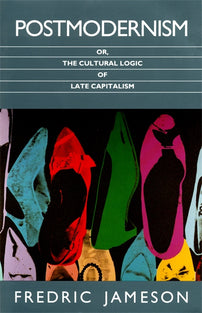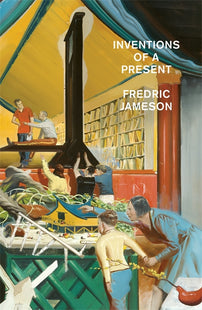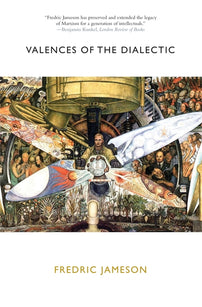Symptoms of the present
For our Jameson at 90 series, Carolyn Lesjak reflects on Fredric Jameson's book Allegory and Ideology and his unique ability to diagnose symptoms of the present.

Much anticipated when it was published in 2019, Fredric Jameson's Allegory and Ideology places front and center two of the central concerns—or perhaps better yet, defining concepts—of Jameson’s work in toto. Organized around a series of categories such as “Historical,” “Musical,” “Political,” Poetic,” and “Literary,” the book is signature Jameson in its reach, moving from Hamlet and Mahler to Third World Literature (including his original, controversial piece on this topic with a new commentary), Dante and Faust. As always, Jameson’s virtuosic skills as a dialectician allow for scalar readings that move from detailed analyses of the individual texts at hand to History writ large. For Jameson, allegory is the mechanism through which to read these scales; or, as he puts it, the four levels of the medieval system of allegory—Anagogical, Moral, Allegorical, Literal—"essentially exhaust the various terrains on which ideology must perform its work" (xvi). It is nothing short of a “ladder to be climbed rung by rung beginning with the simplest elements or forms” (4). Allegory and ideology are thus inseparable and, most significantly, narrative in nature; hence the priority of theology over philosophy, à la Benjamin, and the necessity of understanding allegory as a “social symptom” of the inadequacy of the empirical, of the “illusory surfaces of existential or social life” (34) to capture the Real. In short, allegory is a response to the “dilemmas of representation itself” (34). As such, it is “always with us, in politics, in narratology, in daily life, and in 'common sense'” (207).
[book-strip index="1"]
There are far too many critical interventions and insights in Allegory and Ideology to cover in such a short space. Instead, I will highlight a few broad claims, provocations or questions that have been central to my own work. The first is the book’s crystalline articulation of the work of ideology critique, which has been so bastardized by recent representations of it, whether in the form of various empiricisms, celebrations of the aesthetic, the privileging of surface over depth or the literal over the latent. Against these critiques, Jameson reiterates the twofold nature of ideology critique as both positive and negative, “restorative and ontological,” and, crucially, a “practice of allegorical enlargement rather than one of reduction” (xvi). As with all his work, the Utopian is ever present in this practice: as he notes in response to the frequent misreadings of the status of national allegory in the Third World essay—the result, he suggests of his choice of texts and the moment in which it was written—“the situation is here, as always, everything; and our slogan should be, not only that everything is allegorical, but even more, that all allegory is Utopian!" (215). This is so because it is at the level of the allegorical that class struggle and the collective are situated—hence Jameson’s emphasis on constructivism rather than aestheticization, or the allegory of productivity in which visions of a future collectivity are grounded. The influence of Brecht and his notion of Umfunktionierung can be felt powerfully here, as well as that of Kidlat Tahimik, who in his Perfumed Nightmare celebrates the refunctioning of “vehicles of war” (American military machinery) into “vehicles of life,” the beautifully assembled jeepnies that bring together a joyous aesthetics and artisanal-industrial production.
[book-strip index="2"]
Second, Jameson’s brief references to the Anthropocene offer, to my mind, a provocation to think climate change and, more pointedly, environmental catastrophe, in new ways. As I have suggested elsewhere, by framing the Anthropocene in terms of its “production of reality,” and the “exhilaration that comes with “the perspective of human activity (Tätigkeit), of Marxist productivism, of the construction of nature as well as of human reality” (36), Jameson essentially reverses our relationship to it from one of dire inevitability to one of productive possibility. This is not merely a change in attitude—one of the most ideological of gestures in its mistaking of a collective systemic problem as an individual one—but rather a recognition of the potential for a “radical constructivism”; or the energizing “transmutation of ecological disaster into the terra-forming of earth, and of the population explosion into a genuine human age” (37). As sci-fi as this may sound (and one can hear the echoes of Jameson's utopian-constructivist thinking in Kim Stanley Robinson's The Ministry for the Future), the aim is hardly the creation of a technologically futuristic AI-run world, which, without a fundamental restructuring of late capitalism, would have all the same problems we currently face. Rather, the provocation is to reimagine a form of global communism that takes to heart the fact that “we can really change the world” (348)—Marx was right!—and that the world can only be made genuinely habitable for all through a radical socio-political practice of remaking. As Jameson’s invocation of terraforming implies, our own earth has become something like an alien planet, the grandest possible example of Marx's vision of alienation; to make it now resemble a sustainable earth is to transform it. In the context of recent critiques of Marxist productivist and progressivist narratives, most importantly by Indigenous scholars (Glen Coulthard in Red Skin, White Masks, for example), I think it is especially crucial to see this vision of a collectively transformed nature as radically non-teleological insofar as what such a transformed nature would be is in no way predetermined. Perhaps for this reason, the notion of terraforming is not quite right with its techno-futuristic resonances; but the aim itself and the fact that, as Jameson underscores, it will have to be carried out not by heroes but by mere mortals have been invaluable to my thinking about the commons and what a politics of the commons that is attentive at once to our present ecological crisis and to Indigenous critiques of Marxism might look like.
In the last line of the book, Jameson notes that “symptoms of the future are far less reliable than symptoms of the present” (348). His ability to diagnose the latter not only in Allegory and Ideology but throughout his writing, while keeping the future in his—and our—sights, remains for me, beyond compare.
See all works by Fredric Jameson here. His new book, Inventions of a Present: The Novel in its Crisis of Globalization is out on May 7.
[book-strip index="3"]




